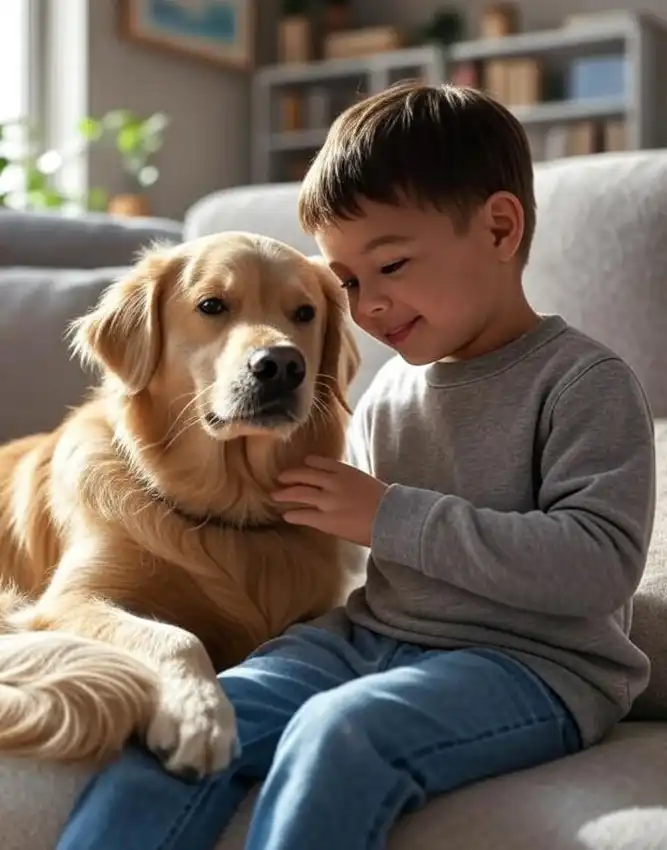Using Pets in Children’s Counseling: A Guide for Parents
Discover how pets aid children’s counseling, easing anxiety and boosting emotional growth. Learn benefits and tips for parents.
When searching for “children counseling,” parents often seek effective ways to support their child’s emotional and mental well-being. One innovative approach gaining popularity is the use of pets in children’s counseling, also known as animal-assisted therapy (AAT).
This method leverages the natural bond between children and animals to foster emotional growth, reduce anxiety, and build trust in a therapeutic setting.
In this guide, we’ll explore how pets are used in children’s counseling, their benefits, what to expect, and how parents can prepare their child for this unique therapy.
What Is Animal-Assisted Therapy in Children’s Counseling?
Animal-assisted therapy involves trained animals, such as dogs, cats, or even horses, working alongside licensed therapists to support children during counseling sessions. These sessions aim to address emotional, behavioral, or psychological challenges, such as anxiety, depression, trauma, or social difficulties. Pets provide a non-judgmental presence, helping children feel safe and more open to expressing their feelings. This approach is particularly effective for children who struggle with traditional talk therapy or have difficulty communicating emotions.
Animal Assisted Play Therapy: Professional Guide
Dive into the transformative world of Animal Assisted Play Therapy™ (AAPT) with this comprehensive guide, drawing from the authors’ impressive 75 years of combined experience in the field. This essential resource is designed for a wide range of professional practitioners, particularly mental health professionals, offering invaluable insights into integrating animals into therapeutic practice. Beyond traditional therapy, the book’s flexible approach and methods can be easily adapted by allied health professionals such as physical, occupational, speech, and recreational therapists, as well as educators and school counselors, broadening its impact across various therapeutic and learning environments.
This book highlights how AAPT infuses the therapeutic process with playfulness, humor, and lightness, making it beneficial for clients of all ages. A core focus is on relationship building, emphasizing the crucial development of positive, mutually respectful bonds between therapists and therapy animals, where the animals’ voices and choices are honored. This foundational principle provides a powerful model for clients, enabling them to strengthen their relationships not only with therapy animals and their own companion animals but also within their human families and communities. Through numerous illustrative case examples, the authors clearly demonstrate the practical application of these techniques with diverse animals, including dogs, horses, and cats, making this a vital addition to any practitioner’s library.
Pros
- Authored by experts with 75 years of combined experience in animal-assisted therapy.
- Highly valuable for mental health professionals and allied health practitioners.
- Emphasizes the crucial role of playfulness, humor, and lightness in therapy.
- Strong focus on fostering mutually respectful relationships between therapists, animals, and clients.
- Applicable for clients of all ages and various animal species (dogs, horses, cats, etc.).
- Includes many illustrative case examples for practical understanding.
- Provides a framework for strengthening client relationships within their own lives.
Benefits of Pets in Children’s Counseling
The inclusion of animals in counseling offers numerous advantages for children’s mental health:
- Emotional Comfort: Pets provide unconditional love and acceptance, creating a safe space for children to share their thoughts and feelings.
- Reduced Anxiety: Interacting with animals can lower stress levels, as petting or playing with a therapy animal releases calming hormones like oxytocin.
- Improved Communication: Children who are shy or reluctant to speak may find it easier to open up when engaging with a pet, facilitating better communication with the therapist.
- Enhanced Trust: The presence of a friendly animal can help build trust between the child and the therapist, fostering a stronger therapeutic relationship.
- Social Skill Development: Interacting with animals can teach empathy, responsibility, and social cues, which are valuable for children with social or behavioral challenges.
Handbook on Animal-Assisted Therapy, 6th Edition
The Handbook on Animal-Assisted Therapy, Sixth Edition, stands as the definitive textbook and comprehensive reference for clinical practitioners in the dynamic field of Animal-Assisted Interventions (AAI). This updated edition provides the essential evidence-based foundation for the efficacy of AAI as a therapeutic treatment, alongside practical guidelines for its implementation. From the meticulous selection of the ideal therapy animal to its effective application with diverse patient populations, this handbook covers every crucial aspect. Featuring 15 new chapters, it delves into contemporary topics such as cultural considerations in AAI, cutting-edge research methodologies, evolving standards of practice, and much more, ensuring professionals are equipped with the latest knowledge.
Organized into four insightful sections, the book thoroughly explores the conceptualization of the profound human-animal bond, outlines best practices for AAI professionals, addresses vital considerations related to animal selection, training, and welfare, and details the utilization of AAI across various special populations and for specific disorders. This invaluable resource not only summarizes current research on Animal-Assisted Therapy (AAT) but also serves as an indispensable study guide for those preparing for the Animal Assisted Intervention Specialist Certification Exam, providing a robust framework for safe, effective, and ethical work with therapy animals.
Pros
- Leading textbook and reference for clinical AAI practitioners.
- Provides evidence-based support for Animal-Assisted Therapy effectiveness.
- Comprehensive guidelines from animal selection to patient application.
- Fully updated with 15 new chapters on culture, research, and standards of practice.
- Covers AAT application with diverse special populations and specific disorders.
- Excellent study guide for the Animal-Assisted Intervention Specialist Certification Exam.
- Summarizes the latest research in Animal-Assisted Therapy.
Cons
- Primarily aimed at clinical professionals; may be too technical for general readers.
- As a comprehensive handbook, it may be quite dense for quick reference.
How Pets Are Integrated into Counseling Sessions
In children’s counseling, pets are carefully selected and trained to ensure they are gentle, responsive, and well-suited for therapy. The therapist may incorporate the animal in various ways, depending on the child’s needs and the session’s goals:
- Icebreaker Activities: The therapist might start by encouraging the child to pet, play with, or talk to the animal to ease them into the session.
- Storytelling or Play: Pets can be part of imaginative play or storytelling, helping children express complex emotions indirectly.
- Skill-Building Exercises: Tasks like grooming or walking a therapy dog can teach responsibility and boost self-esteem.
- Calming Techniques: Petting or cuddling an animal can be used to help children manage anxiety or emotional distress during sessions.
Therapists ensure that the animal’s role aligns with the child’s therapeutic goals, whether it’s addressing trauma, improving social skills, or managing stress.
Handbook: Animal-Assisted Interventions & Therapy, 5th Ed.
Discover the profound impact of incorporating animal-assisted therapy (AAT) into your practice with the Handbook on Animal-Assisted Therapy: Foundations and Guidelines for Animal-Assisted Interventions, Fifth Edition. This updated volume is an essential resource for therapists and practitioners seeking to understand and implement effective AAI. Featuring seven brand-new chapters and substantial revisions to over 75% of its content, this handbook highlights the latest advancements in the field. It provides clear guidance on how to design and execute animal-assisted interventions, explores the empirical efficacy of AAT across various disorders, and addresses its application with diverse patient populations including children, families, and the elderly.
The book comprehensively covers the “why” and “how” of integrating animals into therapeutic settings, offering practical guidelines and best practices for leveraging animals as therapeutic companions. It delves into specific types of patients and environmental situations where AAT can be most beneficial. Furthermore, this edition expands on the use of various animal partners in AAI, including insights into working with cats, dogs, birds, and horses. Whether you’re interested in counseling, psychotherapy, or addressing specific disorders, this handbook provides the foundational knowledge and practical tools necessary to successfully integrate animal-human interactions into your clinical practice.
Pros
- Highlights significant advances with 7 new chapters and 75% revised content.
- Guides therapists on designing and implementing animal-assisted interventions.
- Explores the efficacy of AAT for various disorders and patient populations.
- Covers AAT use with children, families, elderly, and in diverse settings.
- Includes guidelines and best practices for using animals as therapeutic companions.
- Discusses AAI involving cats, dogs, birds, and horses.
- Addresses both the rationale (“why”) and methodology (“how”) of AAT.
Cons
- Primarily aimed at professional therapists; may be complex for general readers.
- Focuses on interventions, less on theoretical foundations compared to some academic texts.
Is Animal-Assisted Therapy Right for Your Child?
Not every child is a candidate for pet-assisted counseling. Parents should consider the following factors:
- Comfort with Animals: Children who are afraid of or allergic to animals may not benefit from this approach. Therapists typically assess this beforehand.
- Specific Needs: Animal-assisted therapy is particularly effective for children with anxiety, autism spectrum disorder, trauma, or social challenges, but it may not suit every condition.
- Therapist Qualifications: Ensure the therapist is licensed and trained in animal-assisted therapy, with a certified therapy animal.
Parents should consult with a counselor to determine if this method aligns with their child’s needs and preferences.
Preparing Your Child for Pet-Assisted Counseling
To make the most of animal-assisted therapy, parents can take these steps:
- Discuss the Process: Explain to your child that they’ll meet a friendly animal during counseling. Highlight that it’s a safe and fun way to talk about their feelings.
- Address Fears or Allergies: If your child is hesitant around animals, share this with the therapist to ensure a tailored approach.
- Set Realistic Expectations: Let your child know that the pet is there to help them feel comfortable, but the focus will still be on working through their emotions.
- Encourage Openness: Reassure your child that the therapy setting, with or without a pet, is a safe place to express themselves without judgment.
What Parents Should Know About Safety and Ethics
Safety is a priority in animal-assisted therapy. Therapy animals undergo rigorous training and health checks to ensure they are suitable for working with children. Reputable counseling centers follow strict guidelines to maintain a safe and hygienic environment. Parents should inquire about the therapy animal’s training, the therapist’s credentials, and the facility’s protocols to feel confident in the process.
Additionally, ethical considerations are key. Therapists ensure that animals are treated with care and respect, with regular breaks and monitoring to prevent stress. Parents can ask about the animal’s welfare and the therapy program’s ethical standards.

Finding a Qualified Therapist for Animal-Assisted Counseling
To find a therapist who uses pets in children’s counseling, start by researching licensed professionals in your area who specialize in animal-assisted therapy. Look for certifications from organizations like the American Counseling Association or Pet Partners, which train and certify therapy animals. You can also ask your child’s pediatrician or school counselor for recommendations. When choosing a therapist, consider their experience with children, their approach to therapy, and how they integrate animals into sessions.
Supporting Your Child’s Journey in Counseling
Animal-assisted therapy can be a powerful tool in children’s counseling, offering a unique way to support emotional growth and healing. By understanding how pets are used, their benefits, and what to expect, parents can make informed decisions about whether this approach is right for their child. Always communicate openly with the therapist to ensure the therapy aligns with your child’s needs and goals. With the right support, pets can help your child feel more comfortable and confident in their counseling journey, paving the way for meaningful progress.
FAQs About Using Pets in Children’s Counseling
Explore common queries about using pets in children’s counseling for better understanding.
What is pet-assisted therapy in children’s counseling?
Pet-assisted therapy uses trained animals like dogs to support children’s counseling, easing anxiety and boosting emotional growth through a safe bond.
How do pets help in children’s counseling?
Pets reduce stress, enhance trust, and improve communication, making counseling more effective for kids with emotional or social challenges.
Which animals are used in children’s counseling?
Trained dogs, cats, and horses are commonly used in children’s counseling for their gentle nature and therapeutic benefits.
Is pet therapy safe for all children?
Pet therapy is safe for most kids, but those with allergies or fears may need alternative approaches assessed by a therapist.
How to prepare my child for pet-assisted counseling?
Discuss the therapy, address fears, and set expectations to help your child feel comfortable with pets in counseling sessions.
What benefits can my child gain from pet therapy?
Pet therapy offers emotional comfort, reduced anxiety, and improved social skills, aiding children’s mental health effectively.
Do therapists need special training for pet therapy?
Yes, therapists require specialized training in animal-assisted therapy to ensure safe and effective sessions with children.
Can pet therapy replace traditional counseling?
Pet therapy complements traditional counseling but isn’t a full replacement, tailored to enhance specific emotional needs.
How often should my child attend pet therapy?
Frequency depends on the child’s needs, typically weekly sessions, as recommended by the therapist for best results.
Where can I find pet-assisted counseling services?
Look for licensed therapists specializing in animal-assisted therapy through local counseling centers or pediatric referrals.




